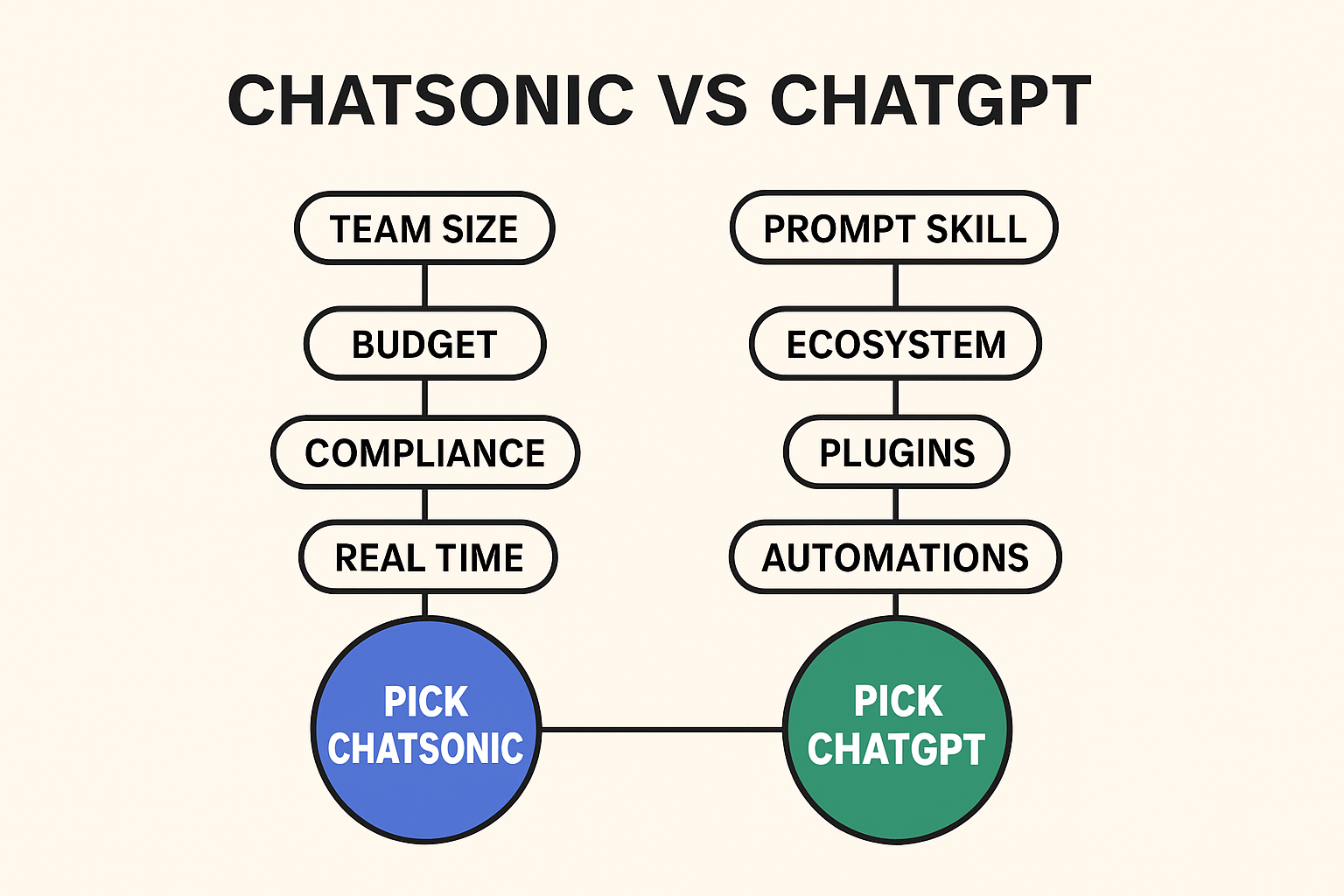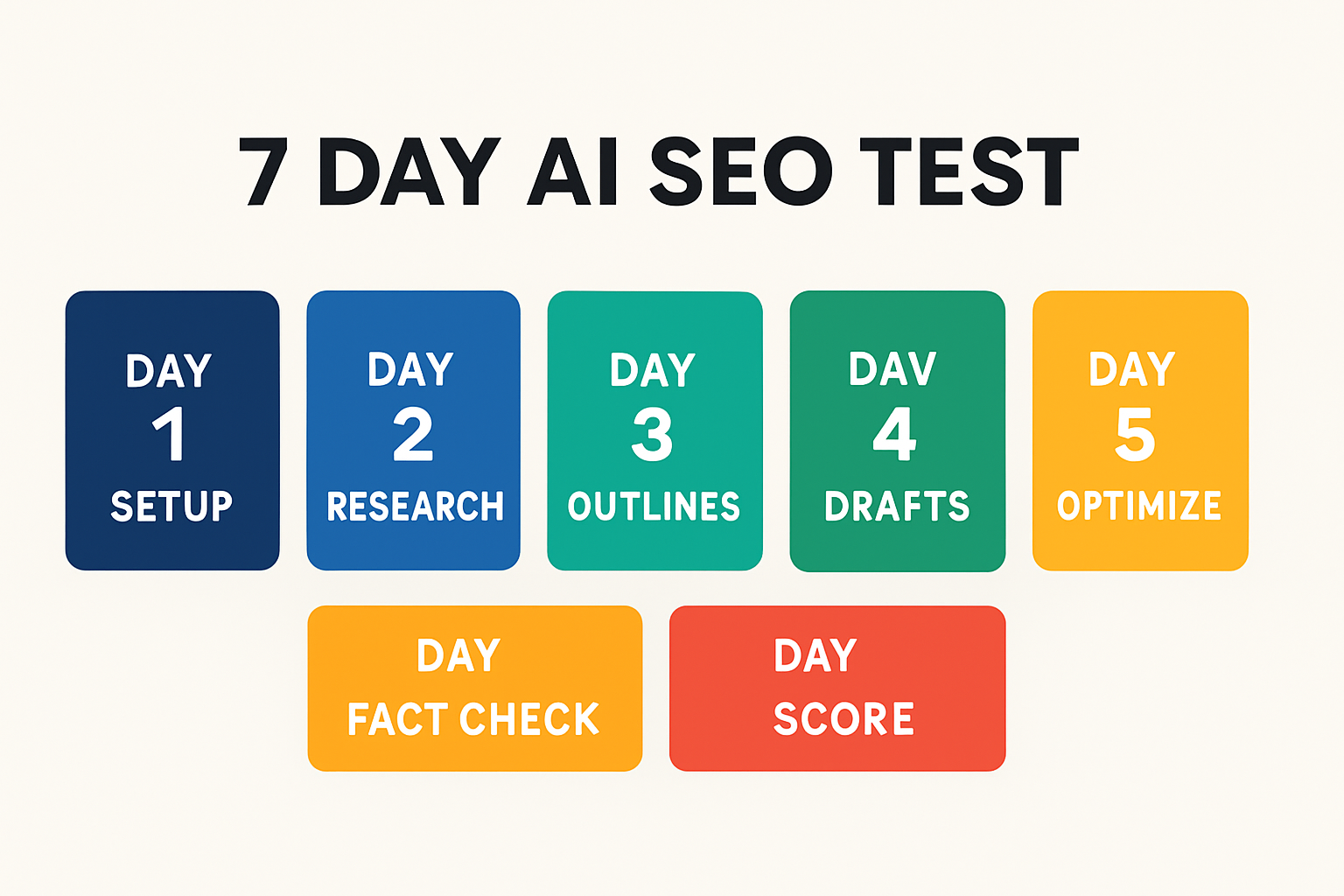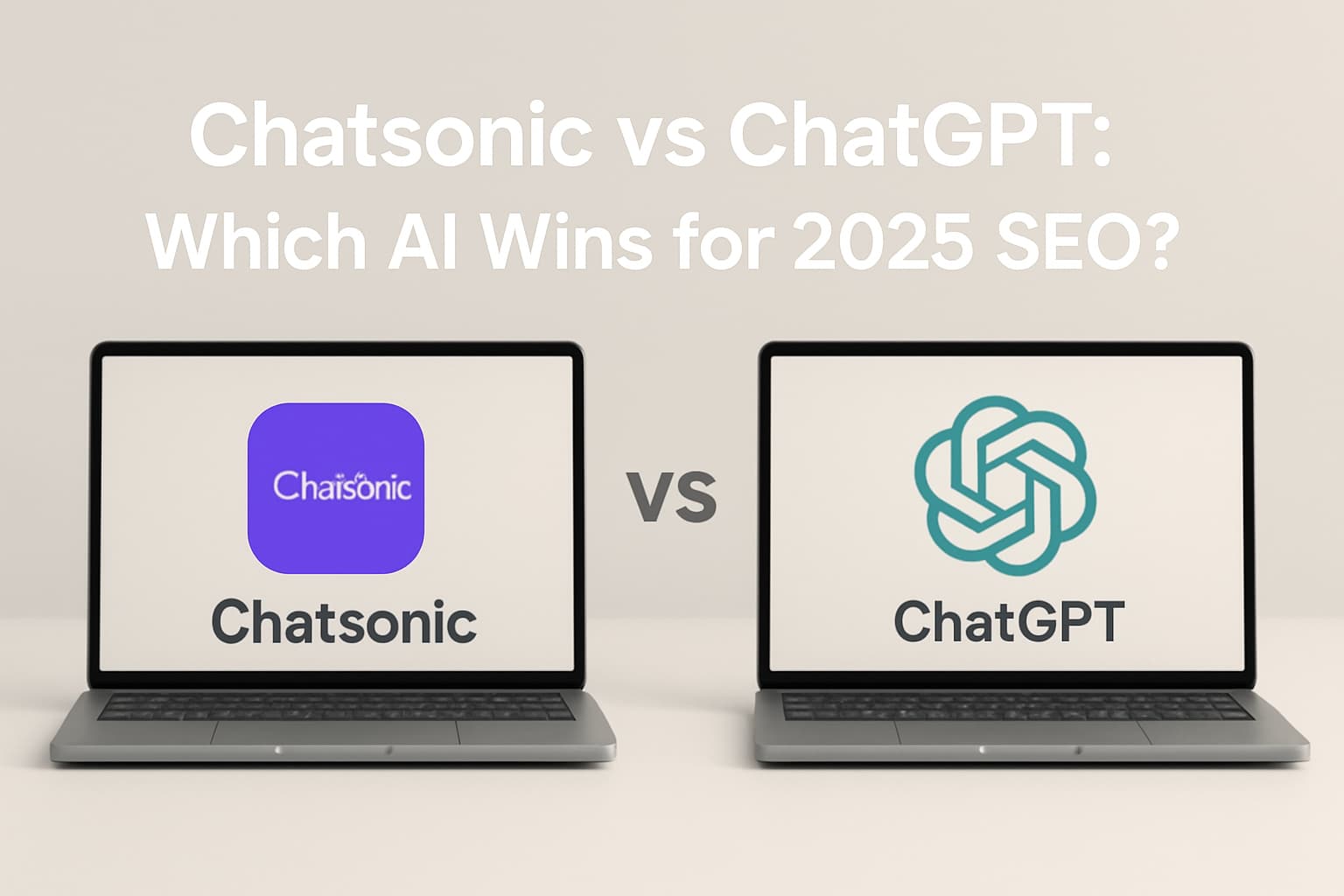Comparing Chatsonic vs ChatGPT for SEO in 2025? This guide gives you a fast, practical answer—then a deeper, testable breakdown to validate the best fit.
You’ll see what changes for marketers with free vs paid plans, where each excels for briefs, long-form drafting, and research, and how to pair either with SEOsolved to actually publish 30–60 SEO-grade articles monthly.
Who this comparison is for (and how to use it)
This is for product-aware buyers deciding between Chatsonic and ChatGPT for SEO content and growth. If your priorities are fast ideation, reliable drafting, real-time research, and measurable rankings—not just “cool AI”—you’re in the right place.
- Skim the quick verdict to shortlist a tool in under 2 minutes.
- Use the feature showdown to compare SEO workflows end-to-end.
- Follow the 7-day evaluation plan to fairly test both tools on your own topics.
- See how SEOsolved adds the strategy and publishing engine behind either choice.
We’ll reference common tasks like chatgpt login, exploring writesonic ai templates, and using chatsonic for research and drafting.
Quick verdict: When to pick Chatsonic vs ChatGPT in 2025
Short on time? Start here.
| Scenario | Pick Chatsonic when… | Pick ChatGPT when… |
|---|---|---|
| Real-time research | You want built-in browsing tied to Google Search and quick citations for trend topics. | You prefer native OpenAI browsing or to pair with external research tools. |
| SEO templates & speed | You like prebuilt marketing/SEO templates and a template-first workflow. | You want flexible, free-form prompting and custom structures. |
| Team onboarding | Your team is newer to prompting and benefits from prompt helpers. | Your team already has strong prompt chops and custom SOPs. |
| Budget | You want competitive plans and bundled features in one UI. | You value model breadth, plugins, and a large ecosystem. |
| Compliance & governance | You prefer template guardrails and role-based flows. | You manage governance in-house with policies and review steps. |
Either way, you’ll get further—and publish more—by pairing your chatbot with a strategy and publishing layer like SEOsolved.

What is Chatsonic (by Writesonic)? Core strengths and trade-offs
Definition: Chatsonic (by Writesonic) is a conversational AI with SEO-focused templates, real-time web access options, and image generation—positioned for marketing teams that want fast briefs, outlines, and drafts.
- Templates for marketers: Campaign, blog, and ad formats help non-experts produce on-brand drafts quickly.
- Web-connected workflows: Some modes integrate search to surface fresher facts for time-sensitive topics.
- Image generation: Create basic visuals alongside copy.
- Model-agnostic options: Access to multiple LLMs within one interface, depending on plan.
Trade-offs: Template-first tools can limit deep customization, and you may still need a separate strategy layer for keyword research, briefs, and interlinking at scale.
Chatsonic AI assistant and app experience
The chatsonic app organizes prompt templates for blogs, ads, and social, making ai chat sonic sessions predictable for non-experts. Prompt-improvement helpers lower the learning curve for teams new to prompting, and an chatsonic ai assistant can speed up campaign ideation.
Reviewers note that Chatsonic leans into speed and marketing outputs, while ChatGPT excels in flexibility and natural interaction—handy if your workflows are more free-form.
Plans, pricing, and getting started
Chatsonic offers a range of plans, frequently including a chatsonic free trial and competitively priced paid tiers. To start, create a chatsonic login (or writesonic login) and pick a plan based on your content volume and web access needs. Pricing can vary by model access and credits, so confirm the latest details on their site.
What is ChatGPT? Core strengths and trade-offs
ChatGPT is a general-purpose conversational AI useful for ideation, editing, and custom workflows. Marketers often use it for message testing, outline generation, long-form drafting, and structured data transformations.
- Strengths: Flexible prompting, large plugin/integration ecosystem, and broad community know-how.
- Trade-offs: Web access and advanced features depend on plan; teams must design their own SOPs and guardrails.
Free vs paid: What actually changes for marketers
With chatgpt free, you can ideate, outline, and draft—but with limits on throughput, reliability at peak, and advanced features. Paid plans typically add faster models, better multimodal support, browsing, and higher rate limits—important for teams publishing consistently.
Feature showdown for SEO content operations
How do these tools support a repeatable SEO pipeline—briefs, outlines, long-form drafts, brand voice, and internal linking?
- Briefs and outlines: Chatsonic’s templates get you to a first pass faster; ChatGPT’s flexibility is better for custom content architectures.
- Long-form drafts: Both can draft 1,500–2,500 words when well-prompted; structure and factuality depend on your guidance and sources.
- Brand voice: Both support tone examples; Chatsonic’s template guardrails can help new contributors stay on-message.
- Internal linking: Both need a strategy layer; this is where writesonic SEO add-ons or platform workflows help—but an external orchestrator is ideal.
Research and freshness: Staying current and citing sources
For trend-sensitive or news-driven topics, Chatsonic’s browsing modes are designed to surface recent results and cite pages inline. ChatGPT can browse depending on plan/features, but many teams still pair it with a research-first tool like Perplexity-style workflows. For rigorous citations, consider a dedicated research step regardless of chatbot.
Long-form drafting, tone control, and factual accuracy
Both tools can produce strong long-form drafts with clear prompts, style guides, and fact-check steps. Chatsonic’s chatsonic ai writer templates help control format and tone. ChatGPT’s free-form prompting suits teams comfortable with detailed instructions and iterative edits.
On-page SEO aids: briefs, keywords, and optimization
You’ll find prompt templates and suggestions in both ecosystems, yet specialized platforms still matter for keyword discovery, clustering, and on-page QA. If your plan involves publishing dozens of posts monthly, pair your chatbot with an orchestrator that handles interlinking and topic coverage.
Real-time web access and browsing: Where each tool excels
Chatsonic emphasizes real-time results via search integrations and citations. ChatGPT’s browsing can be strong on paid tiers, but teams focused on depth often prefer pairing with research-first tools for source auditing. For always-current claims, build a repeatable “collect sources → draft → verify” loop, not a single-pass prompt.
Multimodal workflows: Images, uploads, and screenshots
Chatsonic includes image generation and can support visual content within one interface. ChatGPT offers robust multimodal features on certain plans, including understanding images and files—useful for turning PDFs or screenshots into structured content. If you need a chatgpt alternative with image upload, evaluate which modes your plan supports before committing.
Output quality, safety, and governance
Both ecosystems include prompt guardrails and safety layers. Chatsonic’s template-first approach can reduce off-brand outputs for new users. Enterprises should still maintain editorial guidelines, bias checks, and a human QA pass. Remember: Google prioritizes quality and relevance over how content is produced; focus on expertise and sources.
Speed, rate limits, reliability, and support
Performance varies by plan and model. Some reviewers highlight Chatsonic’s fast response behavior for conversational tasks, which can help during peak production sprints. ChatGPT’s reliability is strong on paid tiers and benefits from mature infrastructure; high-velocity teams should still design batch-friendly SOPs and retries.
Teams, collaboration, and data controls
Chatsonic’s template guardrails suit teams onboarding new contributors, while ChatGPT’s flexibility supports power users. For US businesses, confirm data retention settings, export options, and role/permission models. If you must control who can publish, you’ll benefit from a content ops layer with approvals and version history.
Integrations, APIs, and extensibility
Chatsonic plugs into marketing-friendly workflows and offers a model-agnostic experience depending on your plan. ChatGPT integrates widely via APIs, plugins, and third-party tools—useful for custom ETL, CMS hooks, and analytics. Map your stack first: analytics, CMS, DAM, research, and QA. Then fit the chatbot where it amplifies—not replaces—those layers.
Pricing and ROI: SMBs, startups, and enterprises
Expect evolving pricing. Historically, paid ChatGPT has been in the ~$20/month range, while Chatsonic has offered competitive tiers and trials. Your ROI hinges less on per-seat price and more on throughput, review costs, and how many SEO-grade pages you publish and rank.
- Small teams: One paid seat + a clear playbook can replace piecemeal freelancers for first drafts.
- Agencies: Templates and SOPs reduce variance across client websites—but you still need strategy and QA.
- Enterprises: Governance and source tracking matter; count the cost of rework and approvals.
Alternatives if neither is a perfect fit
If your workflows are research-first, consider tools built for source discovery and auditing before drafting. If compliance is strict, you may prefer locked-down templates and human-in-the-loop review. Preferences vary by team maturity and stack.
How SEOsolved complements Chatsonic or ChatGPT for ranking
Chatbots draft. Rankings come from consistent strategy, coverage, and authoritative sourcing. SEOsolved is the strategy and publishing engine that turns either choice into a ranking machine.
- Automated strategy: Analyze competitors, discover 500+ keywords, and build a content roadmap without manual research.
- Scale to publish: Generate 30–60 SEO-optimized, credibly sourced blog articles monthly.
- Authority and coverage: Semantic clustering, interlinking, and source management baked in.
- Time saved: Reclaim ~80+ hours/month; spend 10 minutes weekly on approvals and feedback.
Use your preferred chatbot for drafting touchpoints; SEOsolved orchestrates the rest—briefs, sources, outlines, and publishing.
Pair SEOsolved with ChatGPT: Research-to-publish pipeline
- SEOsolved finds opportunities and produces briefs, keyword clusters, and internal link targets.
- Export a brief to ChatGPT via chatgpt login for variant drafting and tone refinement.
- SEOsolved completes optimization, interlinking, and publishes on schedule.
Pair SEOsolved with Chatsonic: Template-driven production at scale
- SEOsolved supplies the roadmap, sources, and angle.
- Paste into chatsonic ai writer templates in the chatsonic app for fast, brand-safe drafts.
- Return to SEOsolved for on-page checks and automated interlinking.
Why SEOsolved over “AI-only” stacks
Chatbots don’t guarantee topic coverage, authority, or publication cadence. SEOsolved delivers the missing layer: strategy, authoritative sourcing, and monthly publication at scale. That’s how you move from drafts to rankings.
Stat Ranking Today with SEOsolved—pair it with your chosen chatbot and ship a full SEO program without adding headcount.
Related reads for deeper context: AI writing tools that rank in 2025, SEO automation software ROI, AI competitor analysis in 7 steps, content gap analysis tools, and Semantic SEO for authority.
7-day evaluation plan: Prompts and tests to run on both
Use this script to fairly benchmark Chatsonic vs ChatGPT on your own topics. Keep a simple 1–5 score for speed, structure, factuality, tone, and SEO fit.
- Day 1: Setup – Prepare two target topics and a style guide. Define success: word count, subheadings, links, and CTA.
- Day 2: Research – Ask for 10–15 sources, then cross-check with your own reading. Note citation clarity and recency.
- Day 3: Outlines – Prompt for a detailed H2/H3 outline with FAQs. Score organization and keyword coverage.
- Day 4: Drafts – Generate 1,800–2,200 word drafts. Judge flow, examples, and hallucination control.
- Day 5: Optimize – Ask for on-page suggestions: title tags, meta descriptions, internal links, and schema ideas.
- Day 6: Fact-check – Verify stats and quotes. Replace weak sources. Add 3–5 authoritative external links.
- Day 7: Score & decide – Tally scores, pick a primary tool, and document SOPs for your team.

Decision checklist (printable)
Use this quick list for a confident choice:
- Workflow fit: Template-first speed (Chatsonic) vs free-form flexibility (ChatGPT).
- Research needs: Built-in browsing vs dedicated research stack.
- Quality controls: Human QA, citations, and editorial SOPs defined.
- Data & compliance: Roles, retention, and privacy requirements met.
- Publishing scale: Plan to ship 20–100+ posts/month with strategy and interlinking.
- ROI view: Cost per ranked page, not just cost per seat.
FAQs: Licenses, limitations, images, and team use
- Is there a free version of Chatsonic or ChatGPT?
- Both typically offer free access with constraints. Free tiers are fine for testing, but SEO teams benefit from paid features and higher limits.
- Can I upload images or files for analysis?
- Depending on plan and mode, both support multimodal inputs. Confirm your tier supports image understanding and file uploads before committing.
- Who owns images generated by the AI?
- Image rights vary by provider and plan. Review the latest commercial-use terms and your organization’s legal policies.
- Can these tools create an internal knowledge base?
- Neither is a full knowledge base system. Use them for drafting, and store approved content in your CMS or documentation platform.
- How do I get consistent brand voice?
- Provide a style guide, examples, and a short reference story. Use templates or system prompts and keep a centralized glossary.
Next steps: Automate your SEO engine
Chatsonic vs ChatGPT is only half the picture. Rankings come from a system that discovers opportunities, drafts with sources, and publishes on schedule. That’s the SEOsolved advantage.
Stat Ranking Today with SEOsolved and pair it with your chosen chatbot to ship a complete SEO program in hours—not months.
